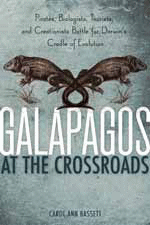SEJournal Online is the digital news magazine of the Society of Environmental Journalists. Learn more about SEJournal Online, including submission, subscription and advertising information.

BookShelf
Galápagos at the Crossroads: Pirates, Biologists, Tourists, and Creationists Battle for Darwin's Cradle of Evolution
By Carol Ann Bassett
National Geographic, $26
Reviewed by ISABELLE GROC
When Charles Darwin visited Galápagos Islands in 1835, he encountered species found nowhere else.
"The archipelago is a little world within itself," he wrote in The Voyage of the Beagle. Since Darwin's visit, this "little world" has changed dramatically and is plagued by environmental, social and economic problems: explosive tourism, rapid population growth, invasive species, illegal harvesting of sea cucumbers and other species, shark finning, widespread corruption and political instability. All of these have led to the fragmentation of fragile ecosystems and the extinction or near extinction of some species. In 2007, UNESCO declared the islands endangered. Although the Galápagos National Park has established some protections, enforcement can be weak and subject to the manipulation of powerful interests such as fishermen.
Galápagos at the Crossroads, by Carol Ann Bassett, examines the problems faced by the islands, called Las Encantadas (the Enchanted islands), by early Spanish explorers. She writes, "The Galápagos Islands now stand at a critical crossroads: To heal and endure as one of the world's most intact natural museums, or to lose most of their biodiversity to human encroachment, just as the islands of Hawaii and Guam have." She focuses on the clashing of human values on the islands and the difficulty of achieving consensus among competing activities: tourism, natural resource exploitation, research and conservation.
Bassett, who teaches environmental writing at the University of Oregon, describes the formation of the Galápagos, its first human settlers, Darwin's explorations and the early scientific inquiries in the first chapter. The following chapters focus on the people of the islands. Each is organized around one or more local characters that represent a problem, a feature or a species of the islands. The result is a refreshing ensemble made up of diverse voices that contribute to an understanding of the islands' complexities.
Through Bassett's interviews, we get to know local heroes protecting the islands. Mathias Espinosa, for example, is a dive master and long-time naturalist who teaches island fishermen — previously involved in the illegal practices of shark finning, sea cucumber harvesting and sea lion mutilation — how to become dive masters. In the highlands of Isabela Island, Jacinto Gordillo an 84-year old former priest turned botanist, raises plants threatened by invasive species.
In her best chapter, Walking with Giants, Bassett describes a gruelling hike up Volcan Alcedo on Isabela Island with wildlife photographer Tui de Roy. Alcedo is home to the largest population of giant land tortoises in the Galápagos. The tortoises became critically threatened after feral goats multiplied on the island, competing for the same grasses and shrubs the tortoises depend on. One of the world's largest island-restoration projects began on Isabela Island in 1998. Teams of sharpshooters and specially trained dogs were hired to eradicate 100,000 feral goats and return Alcedo to the tortoises. Bassett beautifully describes what it is like to be at the volcano's edge among the giant tortoises. The chapter is a ray of light in an otherwise dark account of all the challenges facing the Galápagos.
Despite being peopled with charismatic characters, Bassett's book is sometimes repetitive and disorganized. Often she lets her characters lead the story — choosing voice over structure and tight writing. But her key messages come through: the lack of local environmental education and the damage created by tourism and widespread corruption. By focusing on local people, she fills a gap in the Galápagos literature.
Isabelle Groc is a freelance writer and photographer based in Vancouver, B.C.
** From SEJ's quarterly newsletter SEJournal, Winter 2009-10 issue













 Advertisement
Advertisement 



